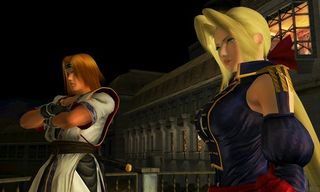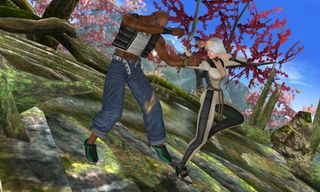It’s been a surprisingly long time since the last Dead or Alive fighting game release – Dead or Alive 4 came out way back in 2005, around the launch window of the Xbox 360. We’ve had some spin-offs and a very bizarre film adaptation in the meantime, but DoA’s core competency of intense one-on-one 3D fighting has been, well, dead for a while now. But Team Ninja’s not content to let one of its crown jewels collect dust, and now Dead or Alive is alive and kicking again, making a comeback in the form of DoA Dimensions on the 3DS. We sat down with Team Ninja’s Yosuke Hayashi to discuss all matter of DoA related subjects, ranging from the current fighting game landscape to the franchise’s future as a post-merger Tecmo-Koei property.
GamesRadar: So it’s been quite some time since the last Dead or Alive fighting game. Could we consider DoA Dimensions to be a sort of Dead or Alive 5, then?
Yosuke Hayashi: It’s actually more of a “best-of” compilation to us. We wanted to give this to fans of the franchise that have been playing the games for a while – a mix of elements and characters from the whole series in a nice little package. First-timers to the series will also be able to get a comprehensive overview of the series.
GR: So why the 3DS, then? People tend to associate DoA with being on the system with the most raw horsepower in order to showcase the game’s visuals.
YH: Our main reason for choosing the 3DS was creating Dead or Alive from a bit of a different perspective… no pun intended. We could have just continued on consoles the way we had up to this point, but we decided we wanted to give players a portable experience – let them hang out together with a bunch of friends and just play it. The 3DS felt like a platform where we could most easily realize that. It gave us the opportunity to really flesh out a fresher, portable experience rather than simply doing a direct port. The 3DS simple felt like a good match for what we wanted to do with the game.

GR: A lot of fighting game fans aren’t very fond of portables, mainly because of the controls. People like their specialized pads and sticks and whatnot. The portability aspect isn’t as big a deal to them when they can go online and play against people there.
YH: We actually invited several top DoA players to test out the game, and they asked us the same questions. But one of the major goals that we had with this game was getting players back into the DoA series and the fighting game genre as a whole. We wanted to change the way fighting games have become so streamlined into a hardcore, ultra-competitive audience. So I think making a portable game gave us a chance to give those people who have fallen out of the fighting game loop to come back into the genre and give it another chance. Expanding the genre beyond consoles could be a key way to invite more people back into the fold and get them to appreciate the beauty of fighting games.
GR: It’s interesting that you say that. One of the big issues with the fighting game scene is that those hardcore players don’t want accessibility. If they feel like their games are being “dumbed down” or made more accessible they’ll pitch a fit. You’ve got a lot of features in this game that could be interpreted as such, like the touchscreen combo execution feature. Are you afraid that there might be a backlash?
YH: When you look at the current sort of hardcore fighting game fan “scene”… that whole community is getting narrower and narrower. Since there’s so much competition there right now. It’s really just the survival of the fittest. They guys who can stay on it and who can win are the ones who have been alive and kicking in the community for the longest time. One thing that we really want people to understand is… taking into account the guys who have been losing. *laughs* They’ve been left behind, and eventually, they go off and do their own thing and separate from the fighting game community. They get sick of fighting games and go to play something else.

I think we’re a bit more conscious of those fans that have separated themselves because they couldn’t keep up with the most competitive players for whatever reason. We wanted to give them something that would be an incentive to come back to the community. DoA Dimensions was made purposefully to help them get back in touch with this sort of fighting game. It might be the Holy Grail to hardcore fighting gamers… it does have the same DoA mechanics for hardcore players to appreciate, but we need to include additional elements to bring back those who have been left behind as well. One of those things is the Tag Challenge mode, where you can pair up two different players of varying skill levels and play together, being evenly matched against a tough opponent. We want to lay something down that will invite people back in and keep this genre healthy in the future.
